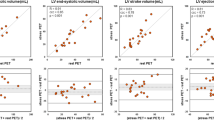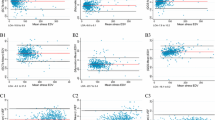Abstract.
Infarct size assessed by myocardial single-photon emission tomography (SPET) imaging is an important prognostic parameter after myocardial infarction (MI). We compared three commercially available automatic quantification algorithms that make use of normal templates for the evaluation of infarct extent and severity in a large population of patients with remote MI. We studied 100 consecutive patients (80 men, mean age 63±11 years, mean LVEF 47%±15%) with a remote MI who underwent resting technetium-99m tetrofosmin gated SPET study for infarct extent and severity quantification. The quantification algorithms used for comparison were a short-axis algorithm (Cedars-Emory quantitative analysis software, CEqual), a vertical long-axis algorithm (VLAX) and a three-dimensional fitting algorithm (Perfit). Semiquantitative visual infarct extent and severity assessment using a 20-segment model with a 5-point score and the relation of infarct extent and severity with rest LVEF determined by quantitative gated SPET (QGS) were used as standards to compare the different algorithms. Mean infarct extent was similar for visual analysis (30%±21%) and the VLAX algorithm (25%±17%), but CEqual (15%±11%) and Perfit (5%±6%) mean infarct extents were significantly lower compared with visual analysis and the VLAX algorithm. Moreover, infarct extent determined by Perfit was significantly lower than infarct extent determined by CEqual. Correlations between automatic and visual infarct extent and severity evaluations were moderate (r=0.47, P<0.0001 to r=0.62, P<0.0001) but comparable for all three algorithms. Correlations between LVEF and visual evaluation of infarct extent (r=–0.80, P<0.0001) and severity (r=–0.82, P<0.0001) were good but correlations were significantly lower for all three algorithms (r=–0.48, P<0.0001 to r=–0.65, P<0.0001). Systematically lower correlations were found in non-anterior infarctions (n=69) and obese patients (BMI ≥30 kg/m2, n=32) compared with anterior infarctions and non-obese patients for all three algorithms. In this large series of post-MI patients, results of infarct extent and severity determination by automatic quantification algorithms that make use of normal templates were not interchangeable and correlated only moderately with semiquantitative visual analysis and LVEF.
Similar content being viewed by others
Author information
Authors and Affiliations
Additional information
Received 19 June and in revised form 29 August 2000
Electronic Publication
Rights and permissions
About this article
Cite this article
De Sutter, J., Van de Wiele, C., D'Asseler, Y. et al. Automatic quantification of defect size using normal templates: a comparative clinical study of three commercially available algorithms. Eur J Nucl Med 27, 1827–1834 (2000). https://doi.org/10.1007/s002590000389
Published:
Issue Date:
DOI: https://doi.org/10.1007/s002590000389




